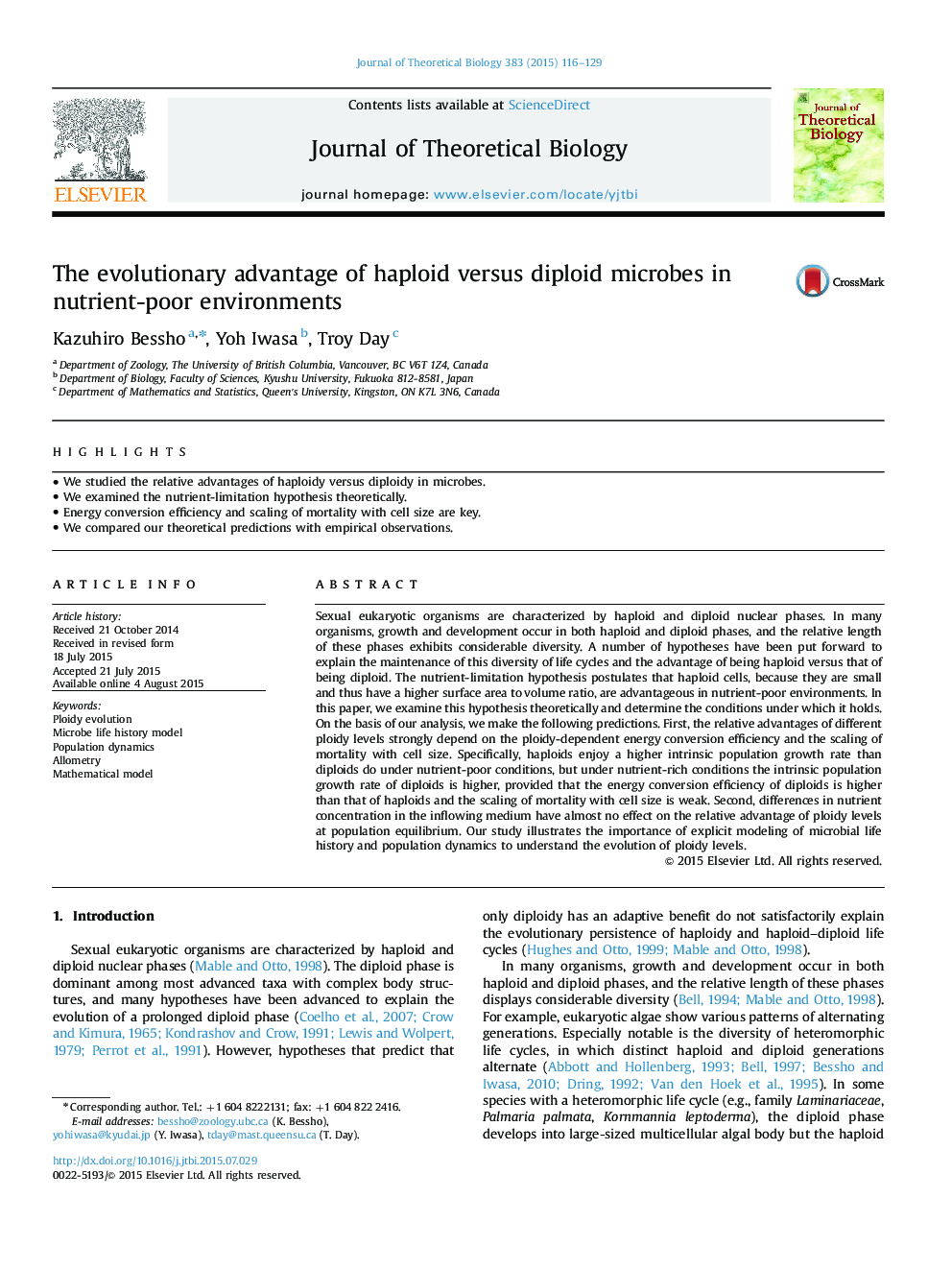| کد مقاله | کد نشریه | سال انتشار | مقاله انگلیسی | نسخه تمام متن |
|---|---|---|---|---|
| 6369727 | 1623827 | 2015 | 14 صفحه PDF | دانلود رایگان |
عنوان انگلیسی مقاله ISI
The evolutionary advantage of haploid versus diploid microbes in nutrient-poor environments
ترجمه فارسی عنوان
مزیت تکاملی میکروب هاپلوئید در مقایسه با میکروب های دیپلویید در محیط های مغذی فقیر
دانلود مقاله + سفارش ترجمه
دانلود مقاله ISI انگلیسی
رایگان برای ایرانیان
کلمات کلیدی
تکامل پلوئید، مدل زندگی میکروب، دینامیک جمعیت، آلومتریوم، مدل ریاضی،
ترجمه چکیده
ارگانیسم های یوکاریوتی جنسی با فازهای هسته ای هپلوئید و دیپلوئید مشخص می شود. در بسیاری از ارگانیسم ها، رشد و تکامل در هر دو مرحله هپلوئید و دیپلوئید رخ می دهد و طول نسبی این فاز ها تنوع قابل توجهی را نشان می دهد. تعدادی از فرضیه ها برای توضیح حفظ این تنوع چرخه های زندگی و مزیت بودن هپلوئید در برابر دیپلوئید وجود دارد. فرضیه محدودیت مواد مغذی فرض می کند که سلولهای هپلوئید، به دلیل اینکه کوچک هستند و بنابراین دارای سطح بالاتری نسبت به حجم هستند، در محیط های مغذی مفید هستند. در این مقاله، این فرضیه را به لحاظ نظری بررسی می کنیم و شرایطی را که تحت آن قرار دارد تعیین می کنیم. بر اساس تجزیه و تحلیل ما پیش بینی های زیر را انجام می دهیم. اولا، مزایای نسبی سطوح مختلف پلوییدی به شدت به کارایی تبدیل انرژی وابسته به پلوییدی و مقیاس مرگ و میر با اندازه سلول بستگی دارد. به طور خاص، هپلوئید ها از نرخ رشد جمعیت ذاتی بالاتر نسبت به دیپلوئید ها تحت شرایط مواد مغذی برخوردار هستند اما در شرایط غنی از مواد مغذی رشد جمعیت ذاتی دیپلوئید بالاتر است، در صورتی که بازده تبدیل دیپلوئید انرژی از هپلوئید بالاتر باشد مقیاس مرگ و میر با اندازه سلولی ضعیف است. دوم، تفاوت در غلظت مواد مغذی در محیط ورودی، تقریبا هیچ تاثیری بر مزیت نسبی سطح پلویید در تعادل جمعیت ندارد. مطالعه ما اهمیت مدل سازی صریح تاریخ زندگی میکروبی و دینامیک جمعیت را برای درک تکامل سطح پلویید نشان می دهد.
موضوعات مرتبط
علوم زیستی و بیوفناوری
علوم کشاورزی و بیولوژیک
علوم کشاورزی و بیولوژیک (عمومی)
چکیده انگلیسی
Sexual eukaryotic organisms are characterized by haploid and diploid nuclear phases. In many organisms, growth and development occur in both haploid and diploid phases, and the relative length of these phases exhibits considerable diversity. A number of hypotheses have been put forward to explain the maintenance of this diversity of life cycles and the advantage of being haploid versus that of being diploid. The nutrient-limitation hypothesis postulates that haploid cells, because they are small and thus have a higher surface area to volume ratio, are advantageous in nutrient-poor environments. In this paper, we examine this hypothesis theoretically and determine the conditions under which it holds. On the basis of our analysis, we make the following predictions. First, the relative advantages of different ploidy levels strongly depend on the ploidy-dependent energy conversion efficiency and the scaling of mortality with cell size. Specifically, haploids enjoy a higher intrinsic population growth rate than diploids do under nutrient-poor conditions, but under nutrient-rich conditions the intrinsic population growth rate of diploids is higher, provided that the energy conversion efficiency of diploids is higher than that of haploids and the scaling of mortality with cell size is weak. Second, differences in nutrient concentration in the inflowing medium have almost no effect on the relative advantage of ploidy levels at population equilibrium. Our study illustrates the importance of explicit modeling of microbial life history and population dynamics to understand the evolution of ploidy levels.
ناشر
Database: Elsevier - ScienceDirect (ساینس دایرکت)
Journal: Journal of Theoretical Biology - Volume 383, 21 October 2015, Pages 116-129
Journal: Journal of Theoretical Biology - Volume 383, 21 October 2015, Pages 116-129
نویسندگان
Kazuhiro Bessho, Yoh Iwasa, Troy Day,
